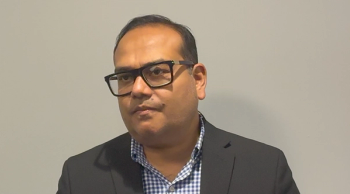
Oncology Nurses Help Identify Signs of Distress in Cancer Patients
As part of our coverage of the ONS Annual Congress, we are discussing the oncology nurse's role in distress screening in cancer patients.
As part of our coverage of the Oncology Nursing Society (ONS) 40th Annual Congress, held April 23 to 26 in Orlando, Florida, we are speaking with Linda Watson, RN, PhD, a certified oncology nurse and lead of Person-Centred Care Integration at Cancer Control Alberta. Dr. Watson will be speaking at this year’s Congress about distress screening in patients with cancer.
-Interviewed by Leah Lawrence
Cancer Network: Can you give us a brief overview of the five main vital signs, and why distress is now considered the sixth vital sign?
Dr. Watson: As is common knowledge, we always think of vital signs as four main parts: blood pressure, pulse, respiration, and temperature. We, as nurses, do this vital sign screening on a regular basis in every shift while we work.
In about 1999, a fifth vital sign was introduced, which was pain. The premise is that, just as we identify and screen patients for what their blood pressure, pulse, and temperature are doing to have a picture of their clinical wellness, we needed to integrate questions around pain. We know that patients often have pain and it is underdiagnosed and undertreated, so we incorporated that.
In the last 10 years, it has become apparent that there is more going for patients beyond pain. That is why the idea of distress as a sixth vital sign was incorporated because cancer patients have told us over and over that the experience of living with cancer and its treatment causes angst across a variety of domains. That changes over the course of the disease, so screening for distress on a regular basis should be incorporated into our everyday assessment of the patient.
Cancer Network: How is distress diagnosed in patients with cancer?
Dr. Watson: A lot of times healthcare professionals perceive that we are really good at identifying what patients are having what problems at what point in time just by looking at them or having a conversation. What we have found through research is that the healthcare provider’s assessment of who is in distress or who needs support for different issues that may be causing them angst is actually not as accurate as it could be just by an overview, and when we compare that with evaluating how patients are actually feeling, we often underdiagnose people’s distress.
We use a self-reported tool where patients can indicate a variety of issues across several domains and experiences as a standardized approach to screening patients for distress, and from that we can identify areas where patients are experiencing high levels of distress.
Cancer Network: What is the role of the oncology nurse when it comes to patients and screening for distress?
Dr. Watson: The important thing to understand about when patients give a self-report is that they could mark a whole bunch of different things down on the tool, but if nobody reviews that tool and helps the patients to contextualize what is most troubling to them and where we should start in helping them manage their distress, then the action of screening is of no use to patients.
There is no therapeutic value for patients just filling in the distress tool. All of the value comes in the review of the tool and that is where the oncology nursing role is so pivotal. Oncology nurses are well-suited to be that person that is closest to the patient and has the time in our assessment with the patient to really ask the questions and review the tool with the patient and say, “What is most troubling to you today? Of all of the things you’ve marked down here, what is most distressing to you and how can I help you with that?” That is actually the heart and soul of the oncology nurse’s role in screening for distress. We are the professional that is closest to the patient and is well-suited to review that tool.
It is important to note that oncology nurses may not be the person or the professional who is best suited to actually manage the distress that a patient is having, but we are able to understand the full scope of the multidisciplinary team and make referrals as appropriate if it is out of the scope of the nurse to manage.
Cancer Network: What types of steps might a nurse take to begin to integrate distress screening into their practice setting?
Dr. Watson: One of the most important things is working out the process of having the patient fill the self-report out before the clinical encounter with the oncology nurse. In my setting, when the patient checks in at the reception desk, we have this screening-for-distress tool given to the patient so that by the time they come and are entered into the clinical exam room they have had time to fill it out before the nurse comes in to review it.
The steps a nurse might take, as part of their interaction with the patient as part of their standardized assessment, they review the tool with the patient. There are a few steps to that assessment.
The first is to have a person-centered conversation to identify what the patient’s priority concerns are. The patient may have indicated several issues on their screening-for-distress tool, so the conversation that I was just referring to should occur, where the nurse would say, “Mrs. Smith, you have a lot of items checked off on this tool. What is most troubling to you today?” That is a really important step because it causes the patient to reflect on their own experience and really start to do some thinking around what the thing is that would be most important for us to start with. That is such an important step in this process to delivering care that is really tailored to the individual and partnering with the patient in terms of finding solutions that might be meaningful.
Once the patient identifies the area that is most problematic for them at the moment, the next step is to then review, “What have you tried to deal with this?” This step is really important because it ensures that we are not wasting our time offering solutions to the patient that they have already tried. Many of our patients are living with cancer for long periods of time and they have high levels of coping strategies already established. It is important in terms of timeliness that the nurse not start to reintroduce ideas that they have already tried. So that step of, “What have you tried to manage this issue?” is an important next step.
From there the nurse can sit back, depending on what the patient is saying, and really start to use their clinical acumen and repertoire of resources and think of solutions that are going to be meaningful to that patient. The next step is to bring those ideas forward to the patient and partner with them and say, “Would you like to have a referral?” or “Do you think that some information might be helpful?” We make them aware that there are services around dietary needs or whatever areas that have come up that the patient had concerns about. All of that revolves around partnering with the patient to provide meaningful resources to the issues that are most problematic to the patient.
We know that distress is caused by physical symptoms, as well as emotional issues and practical issues. So, on the screening-for-distress tool there are several physical issues that the patient has ranked and given their input on how they are doing; for instance, pain, diarrhea, anxiety, numbness, and tingling. Even if the patient does not prioritize those as their most pressing concern, as an oncology nurse, as a clinical practitioner, we have responsibilities to assess those physical symptoms that are related to the treatments they are receiving or the disease they have.
The screening-for-distress tool acts in two ways. One is to drive that person-centered conversation and the second is to highlight areas where patients are having problems that need assessment related to toxicities and physical management.
Cancer Network: That was a great summary. Thank you for speaking with us today about screening for distress in cancer patients.
Dr. Watson: You are welcome. As you can tell, I am quite passionate about this topic, and I know it makes such a difference for cancer patients when they have the ability to really partner with their care providers. Thank you for giving me the opportunity to speak with you about this important practice.
Newsletter
Stay up to date on recent advances in the multidisciplinary approach to cancer.



















































































